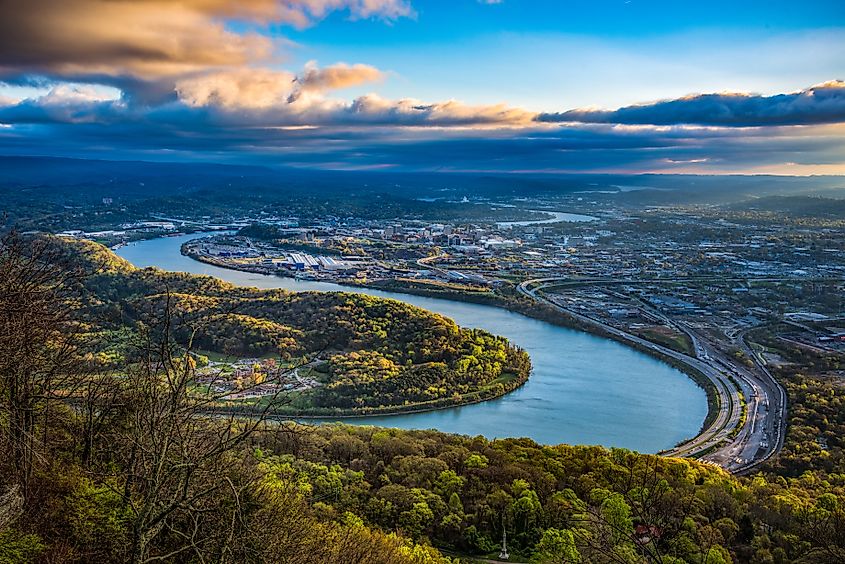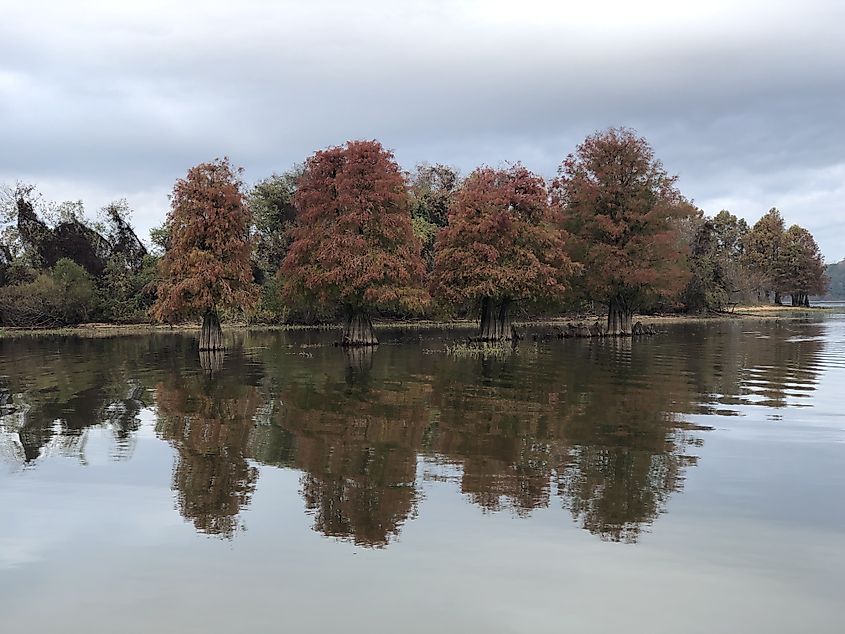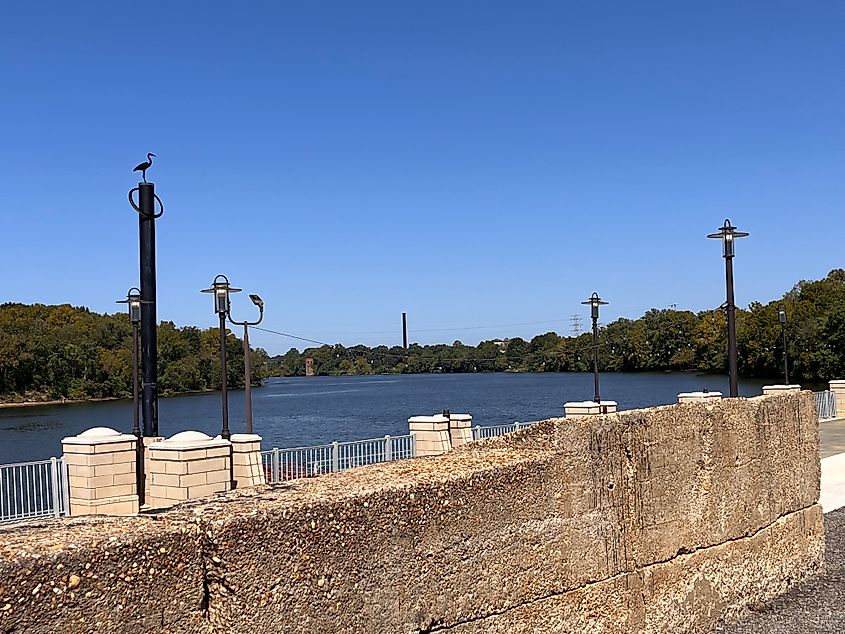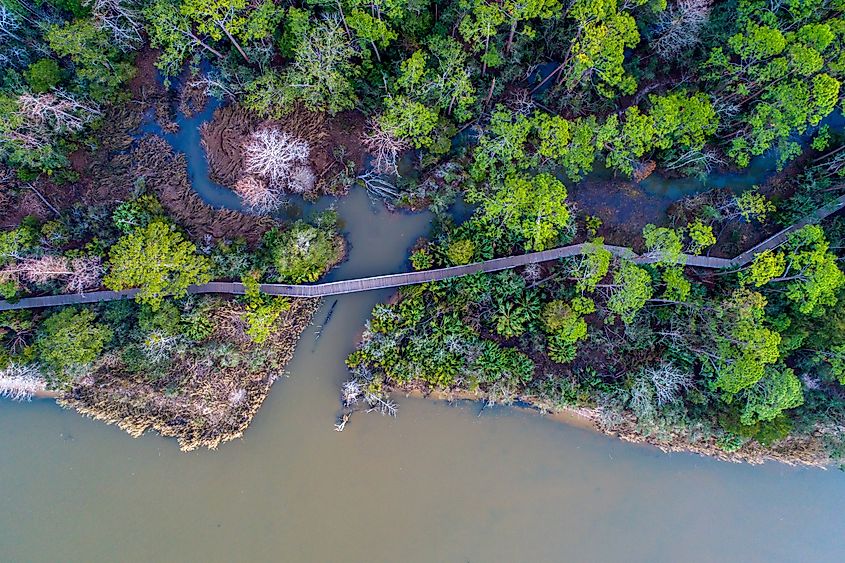Modern dinosaurs, swimming and stalking swamps and sewers, have captured the American imagination for many millennia, for better or worse. American alligators (Alligator mississippiensis) were carved into totems by ancient native peoples and written into grievances by modern Alabamians protesting their nearby relocation, as you will soon learn. Although Alabama is not as synonymous with alligators as Louisiana or Florida, it is home to thousands of alligators, many of which inhabit the following areas between Alabama. Since alligators don’t necessarily participate in census surveys, we consulted various human sources to determine their hotspots. Check out five places in Alabama where you can see these creatures sooner rather than later.
Tennessee River

Northern Alabama was largely free of alligators until Fish and Wildlife relocated about 50 alligators from Louisiana to the Wheeler National Wildlife Refuge on the Tennessee River in 1979. This was an attempt to increase their then-declining population and reduce the beaver population problem. Angry locals responded with their own attempts to reverse the plan, which succeeded under the leadership of Congressman Ronnie Flippo. But catching them wasn’t the case. Fish and Wildlife was only able to remove a few the following year. Nearly half a century later, they are still in Wheeler and have moved even further north, particularly to the town of Huntsville. An eight-foot alligator has long been frightening Sunlake residents around the Edgewater Apartments. They even exist in Tennessee, but whether they are related to those in Alabama is unknown.
Walter F. George Lake (Lake Eufaula)

Hundreds of miles southeast of the Tennessee River, on the Alabama-Georgia border, lies Walter F. George Lake. It was named after Georgia politician Walter F. George, but locals call it Lake Eufaula after the lake town of Eufaula, which was named after the Eufaula tribe of the Creek people. In our opinion, a better name is Lake Alligator. Countless alligators live on an area of around 45,000 hectares, which are among the largest in Alabama and Georgia. A 12-foot, 600-pound alligator said to have been born in the 1970s was pulled from the lake in 2024. Nine years earlier, the lake gave birth to a 13-foot-6-foot, 920-pound monster. However, the Eufaula record holder is believed to be a 14-foot, 1.75-inch giant that was hunted in 2019. Although it was threatened with extinction during the Wheeler Wildlife Refuge fiasco, the population rebounded and an annual hunting season began in 2006. Lake Eufaula is one of five alligator management areas in Alabama where recreational hunting is permitted. Aside from the waters of the Eufaula National Wildlife Refuge, only 20 people are registered to hunt in Lake Eufaula and its tributaries each year. Lake Eufaula is the only area where daytime hunting is permitted, and at least in 2020, it is the only area where captured alligators less than eight feet in length must be released.
Alabama River

The Alabama River meanders for about 300 miles northeast from Montgomery to north of Mobile in the south-central part of the state. Alligators are found throughout the river, with increased sightings near Montgomery, Monroeville and Camden. The last of these produced Alabama’s largest known alligator, which was estimated to be 15 feet long and weigh 1,011 pounds after being hunted in 2014 in the West Central Management Area. However, not all of the Alabama River is a hunting area. Montgomery residents must tolerate these massive predators in their midst, even when they enter popular spots like the Cypress Tree Golf Course at Maxwell Air Force Base. Perhaps that’s why they were eager to mount the record-breaking Camden alligator and display it at the Montgomery Zoo’s Mann Wildlife Learning Museum.
Mobile Bay

American alligators prefer fresh water, but can also tolerate brackish water and even salt water. As such, they inhabit Alabama’s coastal waters, particularly Mobile Bay, which is near the city of Mobile. The brackish bay stretches over approximately 400 square miles and forms the focal point of the coastline Administrative area. Large alligators taken in the area include a 12-foot-9, 524-pound specimen from 2023. Large Alligators saved The area is also home to 13-foot models, which are on display at Alligator Alley in Summerdale. Alligator Alley was founded in 2004 as a refuge for the pesky Florida alligators, whose offspring now number in the hundreds and attract thousands of tourists. “nuisance” alligators, at least in Florida, are those that are more than three feet long and pose a danger to people, pets or property. A mobile equivalent is a 10-foot vehicle that blocked traffic on Interstate 165 in 2024. Of course, “harassment” is subjective, and virtually all humans would be considered a nuisance to these animals. Authorities did the right thing for the highway alligator by pushing it back to its swampland.
Gulf Coast

Mobile Bay flows into the Gulf of Mexico, perhaps the most populous alligator area in Alabama. Although these reptiles are less willing to swim in the saline seas (but probably more common than you think), they love the Gulf Coast swamps that cover the coast Administrative area. East of the resort town of Gulf Shores lies Gulf State Park, which encompasses 6,150 acres of prime alligator habitat, including three lakes that together comprise more than 800 acres and a nature center home to captive alligators. West of Gulf Shores lies the Bon Secour National Wildlife Refuge, which covers approximately 7,000 acres of mostly undisturbed gator territory. Separated from these two protected areas by miles of ocean, Dauphin Island has its own alligator gallery. Although Dauphin is not technically part of the Gulf Islands National Seashore, it extends from this Gatorium preserve.
Alligators are found throughout Alabama, with higher densities in the south, except for a seemingly successful but controversial relocation around the Tennessee River. To see them in ‘Bama, start at Wheeler National Wildlife Refuge in North Alabama, the recipient of said relocation, then head southeast to Walter F. George Lake before heading southwest along the Alabama River to brackish-water Hotspots like Mobile Bay and the Gulf Coast meander. Alligators abound in these five Alabama towns.
